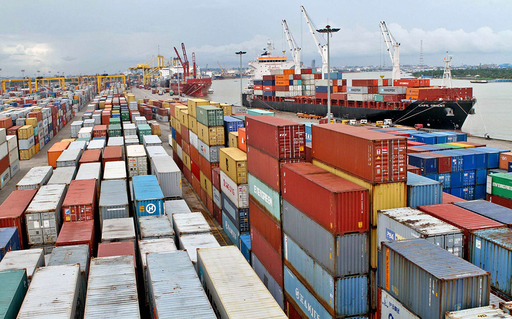
Exporters and economists believe that this amount of exports will be possible as the developed countries' economies have started turning around after tackling the Covid-19 crisis. COURTESY
The Ministry of Commerce and the Export Promotion Bureau (EPB) expect Bangladesh's product and service exports to reach the $50 billion milestone in the upcoming FY22.
Exporters and economists believe that this amount of exports will be possible as the developed countries' economies have started turning around after tackling the Covid-19 crisis.
Five years ago, the commerce ministry set a target to increase Bangladesh's export earnings to $60 billion by 2021. Of this, the exporters were dreaming of earning $50 billion by exporting garments, the country's main export item.
Due to the negative growth in the last fiscal year and the slow growth in the current one amid the pandemic, the EPB reduced the export earnings target by $10 billion, said officials concerned.
EPB Vice-Chairman AHM Ahsan told The Business Standard, "In FY21, the earnings from product exports may reach around $38.5-39 billion and services exports $6.5 billion. That means export earnings may reach around $45 billion in total. We expect more than 10% growth in export earnings in the next fiscal year."
The EPB estimates that the knitwear exports will grow by 11% and woven garment exports by 9% in the next fiscal year.
Mohammad Hatem, first vice-president of the Bangladesh Knitwear Manufacturers and Exporters Association, thinks that the knitwear exports will grow by 15% in the next year. In the 11 months of the current financial year, the export growth in this sector was more than 20%.
On the other hand, Bangladesh Garment Manufacturers and Exporters Association Vice-President Md Shahidullah Azim told TBS that the woven garments exports could grow by 7%, but it will depend on the Covid-19 situation in the country.
Despite the Covid-19 situation, the country's agricultural products exports have grown by more than 16% till May this year. The EPB has projected 12% growth in this sector in the upcoming fiscal year.
The home textile exports have grown by 55% until May this year, and the EPB expects 20% growth in the next fiscal year.
In FY21 the exports of the jute and jute products were positive, while the local jute mills faced a raw material crisis to meet the demand for such products in the international market. The exports of these products have grown by more than 33% till May in this fiscal year and the EPB expects it to grow by 20% in the new fiscal year.
In the first 11 months of FY21, exports of leather and leather goods have grown by 14%, while the EPB expects 12% growth in the next fiscal year.
The exports from the pharmaceuticals sector have also increased due to the Covid-19 pandemic. So far, these exports have increased by 19%, while the government is expecting 15% growth in the next fiscal year.
Besides, the EPB expects 20% growth in the engineering product exports, 8% growth in the frozen fish exports and 15% growth in ceramic products exports.
In the first 11 months of the current fiscal year, the engineering products exports grew by 79%, frozen fish exports by less than 1% and ceramic products by 5%.
The EPB officials said production and international trade collapsed in the wake of the Covid-19 pandemic last year. As a result, Bangladesh, like other countries, witnessed negative growth in exports in the last fiscal year, compared to FY19.
An EPB official said high growth has been achieved in the export of goods in various sectors in the current fiscal year, compared to the weak growth in the last fiscal year. But, it will not be possible to achieve growth at this rate in the next fiscal year. Therefore, in most sectors, the growth target for the next fiscal year has been set lower than this time.
Abdus Salam Murshedy, president of Exporters Association of Bangladesh, told TBS that if the current barriers to exports are removed, it is possible to achieve the target of $50 billion in the next fiscal year. He called for simplification of port infrastructure, customs and VAT system.
Contradicting the EPB's expectation of 8% growth in frozen fish exports, SM Amzad Hossain, one of the country's largest frozen fish exporters and former president of the Bangladesh Frozen Foods Exporters Association, said their exports would not increase in the current situation, but could fall by 25%. However, if the production and export of the vannamei shrimp (whiteleg shrimp) is allowed, the export may increase.
Dr Ahsan H Mansur, executive director of the Policy Research Institute, told TBS, "Demand is growing in Europe and America, and it will grow more. It is a big export market for Bangladesh. So, we have an opportunity to increase our exports in the next fiscal year. The EPB's target of $50 billion export earnings is easily achievable."
According to the EPB, Bangladesh's exports fell by about 17% in the FY20 due to the Covid-19 pandemic. That year, Bangladesh exported goods worth $33.67 billion and services worth 6.13 billion - $39.8 billion in total.
In the first 11 months of the current fiscal year, exports of goods stood at $35.18 billion. The EPB did not release data on service exports after the three-month period from July to September. The country exported services worth $1.45 billion in these three months.
At the beginning of the current financial year, the government had set a target of earning $41 billion from product exports and $7 billion from services – $48 billion in total.












0 Comments